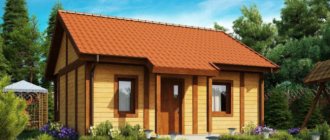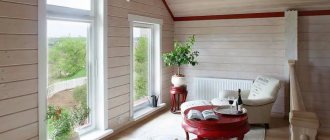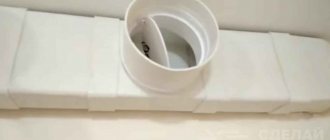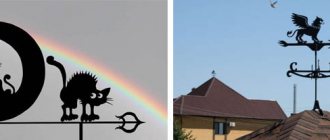When the word “Russian” is pronounced, a person may have many associations. But most often the continuation that comes to mind is “spirit”. It is this phrase that reveals the full depth of the incredible and original atmosphere that Russian style dictates in the interior. It is not without reason that in the age of technology and widespread urbanization, it does not go out of fashion even far beyond the borders of Russia.
Dining room interior in Russian style Source artsten.ru
Features and Distinctive Features
Most of today's youth sincerely believe that the Russian style in home decoration is a shiny samovar on the table, bast bast shoes hanging in one of the corners of the room and a row of wooden nesting dolls in the sideboard. Western propaganda, for commercial purposes, instills exactly this information in the minds of the younger generation.
Handicraft items suitable for decoration in the Russian style Source meridiancentre.ru
Bast shoes on the wall in the hut Source zen.yandex.ru
But those who are interested in the true history of their country know the real state of affairs. Although the national flavor is directly related to folk crafts, this is only one side of the coin. The main distinguishing feature of the Russian style in the interior is its environmental friendliness.
After all, in the old days artificial materials were not used. All houses were built from wood or natural stone. And all the interior furnishings, including household utensils, were made of wood. Even in princely mansions.
Russian style in the interior of a country house Source turbaza.ru
Russian-style tower Source zen.yandex.fr
Moreover, benches or tables were not made from exotic varieties, such as rosewood or wenge. And they used oak, larch, ash or birch. In simpler houses they did not disdain pine. And since stone and wood have a beautiful and characteristic texture, this has always been used.
Even a roughly constructed log house is distinguished by its natural beauty. Inside the house, the logs were polished to a shine, which further emphasized the interesting texture. Almost all the simple furniture in a Russian hut is polished. This makes the item look more colorful and colorful. And what is not polished is festive and brightly colored.
Polished wood when decorated in Russian style Source collections.yandex.ru
Antique wooden utensils Source skarapey.livejournal.com
The second feature that distinguishes Russian interiors is the stove. It is impossible to imagine either a hut or a tower without it. As a rule, it was laid out from homemade raw bricks made from clay, and the finishing depended on the welfare of the house. Simple peasants plastered the surface and whitewashed the top with lime. In rich houses, the stove was lined with natural stone or tiles.
The latter stood out almost as a separate art form. The tiles, molded from clay and of a special design, were fired in a special oven. A wide variety of patterns were applied to its surface. Then it was covered with glaze on top. The finished tiles were distinguished by such artistic value that, in addition to stoves, they were also used to cover many pieces of furniture.
Ancient Russian stove in a hut Source tabak.ferma-biz.ru
An ancient stove with tiles in a mansion Source greslux.ru
In modern conditions, the sale of natural Russian stoves is complicated. In a private house you can still bring the project to life. But even there, it is often replaced with a fireplace and stylized as an ancient stove. In the apartments, partial props are being carried out.
Briefly about the main thing
Russian house style is a combination of national architecture traditions and modern construction technologies.
Natural wood or stone is used to construct the building. Most often, softwood logs or timber are used. Its choice allows you to save on external and internal decoration.
There are three styles: Russian country, Russian hut and tower. Choosing something specific determines the theme of the interior design. In the first case, only stylization is formed, in the second, an atmosphere of modest rural life is created, the distinctive feature of the third direction is luxury, a wealth of colors and expensive handmade accessories.
For the construction of new buildings, standard projects are usually used; it is possible to order an individual project or restoration of an old house in the Russian style. During its implementation, scientific research experience is used to help recreate ancient architectural masterpieces of Russian architecture.
Varieties of style
Russian style in the interior is reflected in three different directions:
- Russian hut.
- Russian tower.
- A separate branch “a la rus”.
In the first case, the decoration of the premises is carried out, repeating the historical similarity with the housing of a simple peasant. The Old Russian hut was not distinguished by its rich decoration. But every detail of the interior is imbued with deep meaning. After all, there are no unnecessary items there. Each of them is exactly in its place and fulfills the role that nature assigned to it.
Russian style in the direction of the hut Source comfortoria.ru
Bedroom interior in Russian style Source dizainvfoto.ru
Pros and cons of buildings
One of the main advantages of the Russian style is the use of natural materials in construction. Wood and stone combine perfectly with each other and allow you to create a cozy home with an original design.
Also, such buildings allow you to pay tribute to your ancestors. A timber base and a properly designed interior will help turn the house into a kind of museum, which will contain objects reminiscent of ancient times.
House made of timber Source stroy-podskazka.ru
Interiors in the ancient Russian style are incredibly beautiful and attractive. You can use a huge number of different decorative elements that will help decorate the room.
The only downside is the high price of materials for construction. Also, not everyone will like the Russian style, so it is better to familiarize yourself with the options for this design in advance.
Choice of colors
The palette for interior decoration also differed from the wealth of the owner. Natural colors predominated in the huts, which added warmth and comfort to the rooms. These are calm yellow shades. Brown was also a popular color. Mostly due to the fact that wooden surfaces were rarely painted at all and were left in their natural beauty.
Country house in Russian style Source Yandex.Zen
Modern Russian style in the interior Source vsaunu777.ru
Muted red tones were added to natural palettes. And also blue and green. These colors are also as close to natural as possible and they were used with pleasure in interior decoration.
Towers were always decorated much brighter than simple huts. The Russian style in the interior of the mansion was distinguished by richer and richer tones, which emphasized the luxury of the furnishings. This was also facilitated by large windows, which were absent in the huts.
Decorating a country house in Russian style Source legko.com
Interior in Russian style in a wooden house Source skalice.ru
Bright colors predominate in both drapery and curtains. And there’s no need to talk about the tablecloths. The festive table covering has always been distinguished by a riot of colors and colorful designs. And since in the old days there was no stainless steel or chrome plating, all iron utensils were covered with bright and rich colors.
Protective symbols in Slavic houses
The limited documentary evidence discovered during excavations of Slavic houses suggests that the Slavs used several traditional amulets to protect their houses. On Slavic houses there were a variety of amulets, which were placed in various places, providing protection to the inhabitants of the house from negative energy, evil glances and misfortunes. Warning signs in Slavic houses were applied in many places, but the most popular were the areas near the entrance doors and windows, where the amulets were made using carvings. It is worth saying that amulets were applied both as separate elements and as part of a complex ornament, which was both a decoration of the house and acted as protection.
Alatyr
In the beliefs of the ancient Slavs, Alatyr was often called “a stone to all stones.” Our ancestors believed that a stone that fell from the sky in ancient times was a symbol of the foundation of all things, especially since the laws of Svarog were inscribed on it. In Slavic houses, this sign was placed above the front door and was one of the symbols in the ornament carved on the platbands. Alatyr made it possible to protect the house and its inhabitants from evil forces, damage and witchcraft, since it has very strong positive energy.
Vseslavets
The Vseslavets amulet has long been associated with the goddesses Lada and Slavunya, who were considered the protector of all living things and the ancestor of all Slavic peoples. Although there is another interpretation of the sign associated with the Polotsk prince Vseslav the Prophet, who at one time was a real defender of the Slavs and their traditions. This amulet was applied by the ancient Slavs near the hearth or stove, since its main purpose was to protect the house from fires, and the inhabitants of the house from quarrels and conflicts.
Tree of Life
Taking into account the fact that the ancient Slavs especially revered the Tree of Life amulet, symbolizing the universe, they were sure to apply this protective sign in their homes. In most cases, it was depicted in the red corner, which was sure to be in every house (it was located diagonally from the stove), and this could be either a symbolic image on a canvas or a wooden plank, or individual elements connected together - branches, flowers, herbs. The Tree of Life protected the house from all kinds of misfortunes, floods, fires, was able to bring prosperity to the house (provided it was constantly working) and influenced the replenishment of the family.
Duniya
Duniya was considered an image of the fusion of living fire - earthly and heavenly, intended to preserve the unity of the clan. Often our ancestors used the symbol for the construction of fiery sacrifices - they had the shape of a Duniya. The Slavs believed that this symbol would become a reliable protection for the home from the penetration of evil forces into it and would not allow anyone to violate the foundations of the home. This sign was traditionally applied to the walls of the house and windows, protecting its residents from troubles.
Lada Star
The Star of Lada the Mother of God is one of the most famous and revered Slavic amulets, so it is not surprising that our ancestors used it not only for individual talismans, but also to protect their homes. The protective symbol Star of Lada applied to the wall created reliable protection for the home from dark forces and troubles, and contributed to good intra-family relationships.
Heavenly Cross
The ancient Slavs had a special relationship with the symbol of the Heavenly Cross, as they considered it one of the most energetically strong and possessing protective properties. Its main protection is the protection of human morality from internal temptations, so it is not surprising that the Slavs often used this sign in the form of a talisman in their homes. It was applied to the walls of the house, and in most cases it was cut out in order to protect family members from rash actions and to maintain peace and harmony between household members.
Rodovik
Rodovik is considered one of the sacred signs of the god Rod, the progenitor of the gods. Our ancestors hung it in their homes over the baby’s bed so that he could draw the strength and positive energy of his ancestors. In addition, the sign was applied to the walls of the house to preserve peace, tranquility, prosperity and prosperity in the house.
Swaor
Swaor is known to many as a symbol of the Family or as a sign of endless celestial movement. Our ancestors applied this symbol to dishes and other household items (there is indisputable archaeological evidence discovered at the sites of settlements of the ancient Slavs). This sign made it possible to attract happiness, prosperity and material well-being into the home.
Triglav
The triune sign, combining Yav, Nav and Prav, as well as the three supreme gods of the Slavic pantheon Svarog, Perun and Svyatovit, made in the form of three intertwined petals, was considered a very powerful amulet that can cleanse the house of dark forces. Many of our ancestors not only carried this symbol with them, but also kept it in a red corner, embroidered it on canvas or simply carved it above the front door, because they believed that its presence could prevent evil forces from entering the house.
Chur
Chur among the Slavs was one of the personifications of a magical shield, which served to protect the house and surrounding areas from evil and negativity. Therefore, this sign was often applied to gates and entrance doors, and it could be painted or carved.
Yarovik
The double-sided amulet Yarovik-Ognevik has long been considered a symbol of the Sun God Yaril, who fills the earth with his strength and power. Our ancestors applied this sign at the entrance to a barn or cowshed in order to create protection for livestock and increase their number. Often this sign was applied in barns and storerooms, protecting the house from hunger and poverty. You can find evidence that Yarovik-Ognevik was applied to roof slopes, shutters, and ceilings, where it served as protection against thieves.
Molvinets
Molvinets is a talisman that has powerful energy that allows you to protect not only its owner, but also his home from the evil eye and damage. The amulet is universal, so it was often applied by our ancestors to household items and walls in the house, protecting its inhabitants from the negativity that was born of the word.
Examples in the interior
Russian style in the interior is, first of all, colorful. Slavic culture has always paid special attention to symbols and drawings. And the latter became a sign of everything primordially Russian. Including design. National painting has absorbed the best elements of folk ornaments. A striking example of this is Khokhloma, Haze and Gzhel.
Folk craft under Khokhloma Source pescups.ru
Garden area and vegetable garden
Fruit trees and shrubs are an invariable component of the Russian estate style. Apple tree, pear tree, plum tree, sea buckthorn, honeysuckle, raspberry, currant and gooseberry have always been popular garden plants in our country.
Medicinal and spicy plants, as well as some vegetables, are grown in small beds, often hidden from prying eyes behind hedges.
Elements of the “Russian hut”
The priority in a Russian hut is what is really necessary for life, what is natural and understandable, and decorations are secondary.
The pieces of furniture are bulky and necessary: chests, benches instead of sofas, shelves made of boards along the walls. A chest is the main piece of furniture: it is both storage for utensils and clothes, and a place to sleep. That’s why they are decorated with love, using forged elements, carvings, and stone tiles.
The indispensable attributes of the hut are a red corner for icons and a whitewashed Russian stove. The place of the red corner is the front free corner on the right; here an embroidered towel is hung, decorated with ears of wheat or artificial flowers, and a lamp is hung.
Household appliances should be hidden in special cabinets, like an old sideboard. Place a samovar with a pipe on a table or bench, hang a bunch of bagels (optional), arrange baskets and cupcakes. The shelves will be decorated with clay and wooden dishes and clay crafts.
Wooden objects will be in place: a hand spinning wheel, a butter churn. If there is an infant in the house, a cradle is suspended from the ceiling, and fishermen decorate the walls with homemade nets.
Lighting is important and necessary
This can become a serious problem if the interior involves permanent residence. The abundance of wood does not have the best effect on the level of illumination - surfaces, especially those not alternating with white plaster, absorb rays of light, making the interior a little gloomy, especially in an apartment with low ceilings.
What you should pay attention to in this case:
- The presence of large windows that will not allow the interior of living rooms to turn into a bathhouse.
- Lightening areas with paint, whitewashing, because white reflects light better than others.
- Active LED lighting, which saves interiors from dim lighting, is excluded.
The following will help you avoid disturbing the authentic atmosphere:
- perforated lampshades simulating lace;
- lampshades with painting and embroidery;
- birch bark lampshades;
- imitation of candles, lamps.
For modern reading, designers have come up with enough solutions. For example, the latest trend is lamps resembling a matryoshka doll made of metal and glass. Even special retro wires can become an interesting accent, allowing historical achievements to be justified.
Advice. In the windows, all plastic elements must be replaced with wooden frames and supplemented with decorative shutters, if desired.
The curtains compensate for the simplicity of their forms with an ornament of flower garlands; lace ruffles are possible. Cornices, certainly wooden, with skillful carvings, will become an additional decoration.
Decoration and furnishings
Various types of wood, such as cherry, birch, ash and pine, vary greatly in both texture and budget, and real solid wood (especially oak) can seem hefty in price.
Lightening completely wooden surfaces is not only aesthetically attractive, but can also be practical.
Companion materials for surface finishing:
- Tiles. Finishing part of the wall in the fireplace area, culinary area of the kitchen.
- Bleached plaster will add light and space.
- Natural stone (granite, marble) - emphasizes the structure of wood.
Creative owners will love the idea of aging or resuscitating suitable designs themselves. Modern improvised means (there are even ready-made kits, for example, for decoupage), varnishes and paints with all sorts of effects (craquelure, patina) take the process to a new level.
They allow you to create on your own that very valuable antique object that gives the room a special flavor: a china rack, a chest of drawers, a wardrobe, a chest.
Advice. Think about not just niches, but screens and doors that hide the necessary equipment for complete compliance and harmony.
For a kitchen in this unique design, manufacturers have provided solid wood furniture (or so-called solid wood), which:
- they will hide behind their facades small and large household appliances that stand out from the concept;
- for the hood, the requirements are taken into account - the shape of the chimney or a special box that hides a modification that is no longer relevant.
- household appliances in retro style, calm colors with copper and brass fittings.











